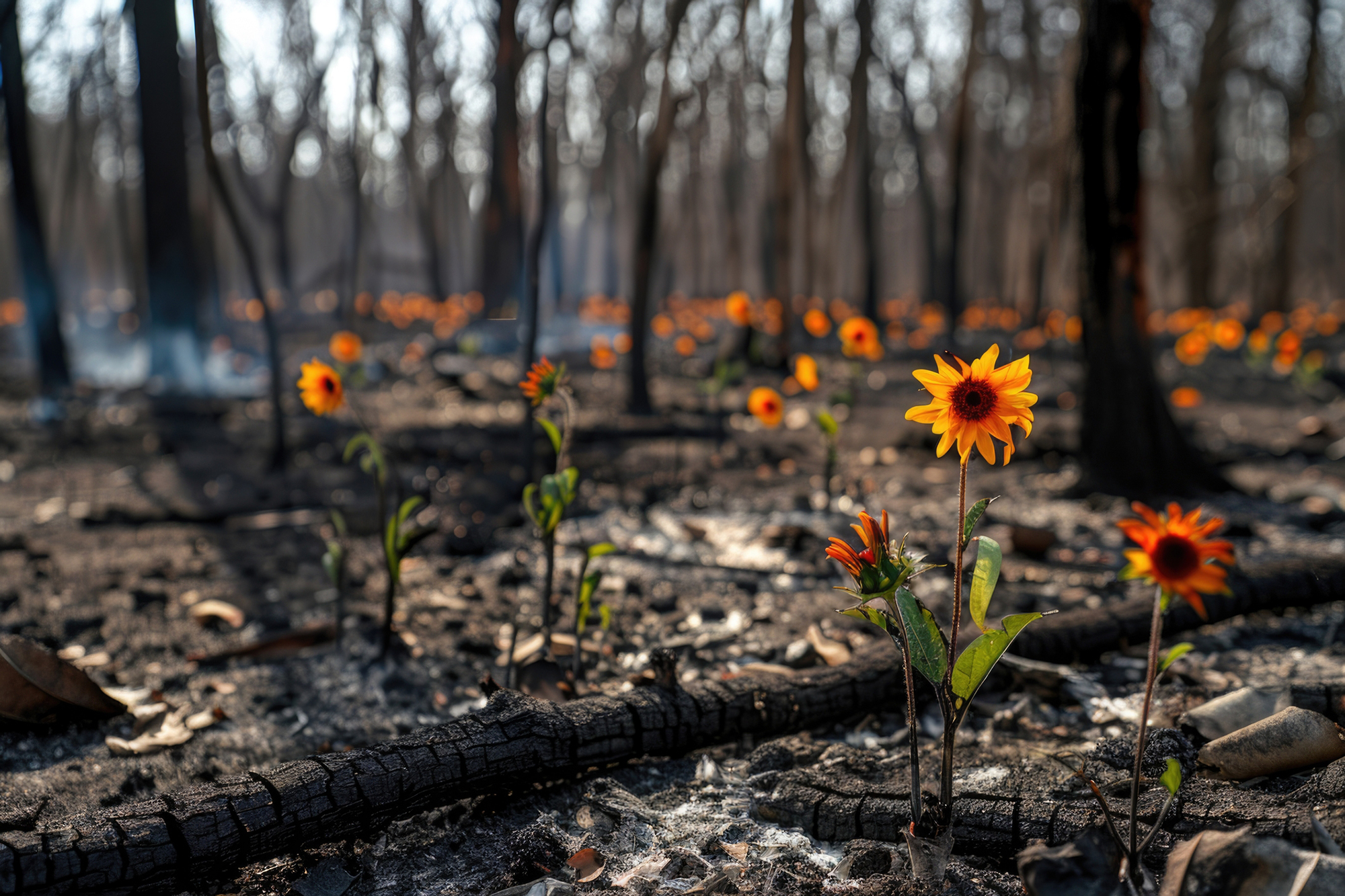Using a strength-based approach in facilitating, training, and supporting means we recognize and support the incredible resilience and wisdom that trauma can ignite in a human being.
Studies show that the majority of trauma survivors don’t develop PTSD, and a large number even report growth from their experience. While trauma is not the path anyone would choose to personal growth, it can be a positive side effect, and aid professionals in a helping capacity to promote further growth.
But There Are BIG Caveats.
Is it Really Post?
Post-traumatic growth implies that the trauma is over. If a learner is still living it, they are focused on trying to survive, and likely not working on personal growth, yet. Think of getting caught in a thunderstorm. You’d need to focus on finding shelter and safety before you can reflect on the resilience and problem-solving that got you to safety. Our learners and clients may be in the thick of it, and we need to respect that.
Expectations Can Add to Burden
It’s also important to recognize that the concept itself can create a heavy expectation for people already overburdened with trauma. It can become one more thing a traumatized person is expected to do or become a source of shame if this ‘growth’ isn’t true for them. Be aware of your own ideas around this narrative.
Beware of the Trope
Society has developed a storyline around trauma: when bad things happen, we should use it as an opportunity to become better. It’s become a cultural trope we see in everything from Superhero movies to pop songs – what doesn’t kill you makes you stronger… right? But is it true? It turns out that the answer is ‘sort of’. Recently, researchers into post-traumatic growth have started questioning whether reports of growth are real or given because the expectation is so pervasive in our culture. And trauma survivors may report growth because believing trauma has a positive result helps them cope with what they’ve been through. Hmmm. Things aren’t as clear as they once seemed.
Complex Outcomes From Suffering and Trauma
Reactions to trauma can lead to positive and negative outcomes simultaneously. Research shows people who’ve experienced high levels of cumulative lifetime adversity can be more compassionate, empathetic, and more willing to engage in pro-social behaviour. There’s also strong evidence they can show increases in creativity and wellbeing. However, trauma is just as likely to cause sufferers to turn away from others and become embittered in life. Trauma can decrease empathy and compassion. As facilitators, it’s important to be aware of this duality.
We Can Help Learners and Clients Find Growth from Trauma
What are the implications for those of us in helping and supporting professions? How can we assist learners and clients in moving toward growth after trauma?
- Don’t add to anyone’s burden by subtly or overtly implying that suffering equals growth and positive change. This expectation can compound distress.
- Create environments and experiences that help individuals build a sense of agency and control, which can reduce overwhelm and help us have the space to process trauma. Give learners voice and choice.
- Provide opportunities for people to reflect, ask the big questions, and put events in context within their lives. Positive post-traumatic growth comes out of processing one’s own responses to traumatic events.
- Recognize that unusual or unexpected events, like trauma, can push people to experience the world from an unusual perspective that can open minds to different ways of thinking and understanding human experience. Encourage creativity and facilitate time and space for it to unfold.
“And once the storm is over you won’t remember how you made it through or managed to survive. You won’t even be sure, in fact, whether the storm is really over. But one thing is certain. When you walk out of the storm, you won’t be the same person who walked in. That’s what this storm is all about.”
– Haruki Murakami
The movies and pop songs don’t have it quite right. Setbacks and adversity do not magically produce growth and build character. Our response to events matters. Pain, despair, and suffering do not mean we are left broken beyond repair. People can heal, and move towards wholeness. Those wounds can be part of our strength. We just need to be conscious of our learners’ and clients’ ongoing journeys.
Learn More
PROFESSIONAL DEVELOPMENT Experience a Different Way to Facilitate, with Change it Up
BLOG Beautiful Minds–Post-Traumatic Growth: Finding Meaning and Creativity in Adversity
PODCAST Hidden Brain: Healing 2.0 – What We Gain From Pain. Eranda Jayawickreme
BOOK Redesigning Research on Post-Traumatic Growth: Challenges, Pitfalls, and New Directions. Edited by Frank J. Infurna and Eranda Jayawickreme, 2021.
RESEARCH
- Toward a More Credible Understanding of Post-Traumatic Growth. Eranda Jayawickreme and Frank J. Infurna, Journal of Personality, 2020.
- Hard-Earned Wisdom: Exploratory Processing of Difficult Life Experience is Positively Associated with Wisdom. Nic M. Weststrate and Judith Glück, Developmental Psychology, 2017.
- Suffering and Compassion: The Links Among Adverse Life Experiences, Empathy, Compassion, and Prosocial Behavio Daniel Lim and David DeSteno, Emotion, 2016.






Eye Movement Desensitization and Reprocessing Therapy for Healthcare Workers and Confronting Trauma and Stress within the workplace
Medical care gurus fulfill a critical role in delivering care and support to males in need, but the pressures of their work can exact a toll on their mental and physical and well-being. Eye Movement Sensory Desensitization and Desensitization EMDR therapy affords a valuable asset for healthcare experts, assisting their path toward recovery, resilience, and well-being.
During this discussion post, we examine the application of EMDR counseling in healthcare settings and discuss its possible positive aspects for handling trauma-related concerns and promoting self-care and strength among heath care treatment professionals.
One of the principal challenges experienced by healthcare professionals is theimpact of workplace trauma and stress on their psychological and emotional health. Eye Movement Desensitization and Reprocessing therapy provides a systematic and evidence-based tactic to trauma treatment that can assist professionals in managing distressing feelings, testing negative philosophy about their move, and cultivating additional adaptive management strategies.
Further, Eye Movement Desensitization and Reprocessing therapy can manage the foundational trauma and psychological distress which may lend in addressing work-related burnout, compassion fatigue, and further stress-related concerns among health care pros, abetting healthcare professionals in finding renewed sense of purpose, meaning, and resilience in their work. By supplying a protected and accessory space for search and healing, EMDR therapy encourages health care practitioners to put first their personal self-care andkeep on administering compassionate care to others.
Moreover, EMDR treatment method’s center of attention in promoting self-preservation and resilience is consistent with the needs of numerous healthcare professionals, who are seeking to find equilibrium and contentment in their stressful roles. By offering effective and accessible trauma treatment, Eye Movement Desensitization and Reprocessing therapy sustains medicine and health specialists in locating comfort and renewal in their existence.
[url=https://www.lkinstitute.com/emdr-ocd-phobias-2024]EMDR IOP for depression[/url]
[url=http://watec.es/]Youngster Educational Support Chances[/url] 6a6fec8